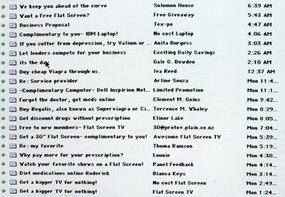Over the past 200 years or so, the principles of modern advertising haven't changed much. If a business wants an audience to purchase certain goods or services, it needs to make a persuasive argument and put it in front of people. As far back as the late 18th century, Benjamin Franklin's Pennsylvania Gazette started including headlines, drawings and other advertising techniques for products along with its usual editorial articles [source: GMU]. If you flip through magazines and newspapers at your local newsstand, although styles and interests may have changed, the basic technique businesses use to communicate with consumers is still the same.
Exactly how businesses get their message out, on the other hand, has changed dramatically and continues to change. The ubiquity of television in our homes, for instance, made it possible for advertisers to market their products to a huge audience during commercial breaks, whether they liked it or not. Telephones eventually gave way to telemarketing, much to the chagrin of families in the middle of dinner.
Advertisement
Another common form of marketing communications is direct mail. When you open up your mailbox hoping to find letters and postcards, you instead see a handful of flyers for local restaurants and retail stores that offer coupons and inform you of upcoming sales. After a quick glance, most people probably end up throwing these ads in the trash. Not only do businesses spend a lot of money for nothing, but lots of paper gets wasted in the process.
The Internet has introduced a new twist on direct mail and given businesses another chance to reach people, a technique known as e-mail marketing. It's a cheap, fast way to reach a large base of customers, and unlike direct mail, it's easy to track the effectiveness of an e-mail marketing campaign electronically. On top of that, it can help save a ton of a paper, since the U.S. Postal Service delivers more than 87 million pieces of direct mail each year [source: Environmental Sustainability Committee]. If done right, it can also provide revenue -- the Direct Marketing Association predicts that for every dollar spent on e-mail marketing in 2008, companies will make $45.65 million in sales [source: Direct].
Sounds great, right? Is e-mail marketing the perfect, inexpensive way to target customers, or does it have any disadvantages? What about spam? To learn about how companies get the word out on their products with e-mail marketing, read the next page.
Advertisement




